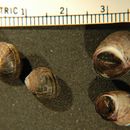Look Alikes
provided by Invertebrates of the Salish Sea
How to Distinguish from Similar Species: This is the most globose local littorina. Others do not have pronounced spiral ridges.
- license
- cc-by-nc-sa
- copyright
- Rosario Beach Marine Laboratory
Distribution
provided by Invertebrates of the Salish Sea
Geographical Range: Alaska to Puget Sound, Sea of Okhotsk, Japan
- license
- cc-by-nc-sa
- copyright
- Rosario Beach Marine Laboratory
Habitat
provided by Invertebrates of the Salish Sea
Depth Range: Very high to low intertidal
- license
- cc-by-nc-sa
- copyright
- Rosario Beach Marine Laboratory
Comprehensive Description
provided by Invertebrates of the Salish Sea
As with other littorinids, the shell is globose with a short spire and a height approximately equal to or somewhat greater than the diameter. There is neither a siphonal notch nor an anal notch. The operculum is horny. The interior of the shell is not pearly. The columella has no folds or ridges, and there is no umbilicus. Littorina sitkana has a diameter almost equal to the height, and sometimes has prominent spiral ridges. It has only about 4 whorls. The apex is not acutely pointed. Its aperture is large and nearly circular, and the interior is purplish or brown. The columella is whitish. The outside is light brown to gray or black. May have yellow or white spiral bands. The animal is black, with black tentacles. Height up to about 2 cm.
- license
- cc-by-nc-sa
- copyright
- Rosario Beach Marine Laboratory
Comprehensive Description
provided by Invertebrates of the Salish Sea
Biology/Natural History: This species can survive long periods out of the water and will eventually suffocate of forced to remain under water. It ranges very high in the intertidal. It feeds on diatoms and fine algae, which it rasps off rockweed and off the rocks themselves. It also eats the black lichen which is found in the high intertidal. During grazing it also eats tiny settled barnacles. Predators include snails such as Nucella lamellosa, seastars such as Evasterias troschelii and Leptasterias hexactis, red rock crabs Cancer productus, nemertean worms such as Amphiporus formidabilis, fish such cockscomb pricklebacks, pile perch, clingfish, and a variety of ducks, surfbirds, and turnstones. The empty shells are used by small hairy hermit crabs Pagurus hirsutiusculus. This species lays its eggs in gelatinous masses on rocks and algae. The capsules look like tiny reddish flattened lemons. Eggs are laid in the spring or fall on Vancouver Island, and in summer in Oregon. One egg mass may contain the eggs of several females, which may help deter dessication. Unlike L. scutulata, the larvae hatch as juveniles and do not have a pelagic stage. Adults also do not range far, usually moving less than 1 meter per month. They are much more active on foggy days. the foot is divided by a median line and the animal crawls by lifting one half of the foot at a time. Individuals on more exposed coasts are smaller with thinner shells and a larger foot, but still did not survive winter storms well. The constant scraping of littorinid radulas has been estimated to scrape as much as 1 cm off of intertidal rocks per 16 years.
- license
- cc-by-nc-sa
- copyright
- Rosario Beach Marine Laboratory
Habitat
provided by Invertebrates of the Salish Sea
Mostly in sheltered areas, on rocks or among algae such as rockweed. Also on pilings and eelgrass. Areas protected from direct sun may have greater concentrations. Often found in and around crevices.
- license
- cc-by-nc-sa
- copyright
- Rosario Beach Marine Laboratory
Littorina sitkana
provided by wikipedia EN
Littorina sitkana is a species of small sea snail, a marine gastropod mollusc in the family Littorinidae, the winkles. It is commonly found in the high tidal zone and the splash zone.
Description
The shell of this winkle has about ten coarse spiral ribs on the last whorl, and has fine spiral microstriae in the gaps between the ribs. Occasionally this ribbing may be missing or it may be ribbed only at the base. The species with which it is most likely to be confused is Littorina subrotundata and comparison of the capsule gland of the pallial oviduct is the best way to distinguish between them.[2]
Distribution
The native range of L. sitkana is the coasts of Siberia, Japan and the Pacific coast of North America extending from Alaska to Oregon.[2]
References

- license
- cc-by-sa-3.0
- copyright
- Wikipedia authors and editors
Littorina sitkana: Brief Summary
provided by wikipedia EN
Littorina sitkana is a species of small sea snail, a marine gastropod mollusc in the family Littorinidae, the winkles. It is commonly found in the high tidal zone and the splash zone.
- license
- cc-by-sa-3.0
- copyright
- Wikipedia authors and editors

